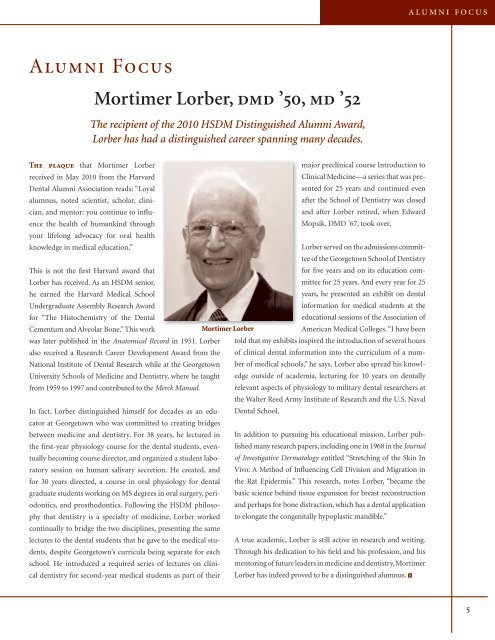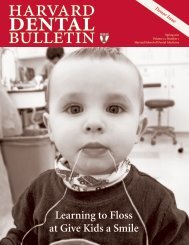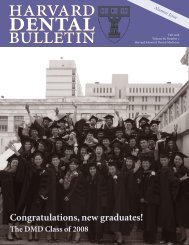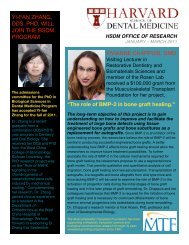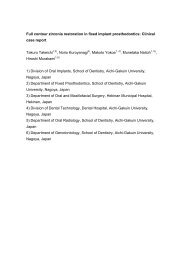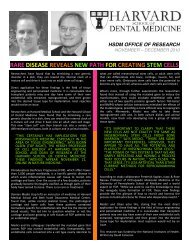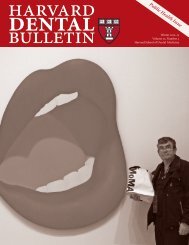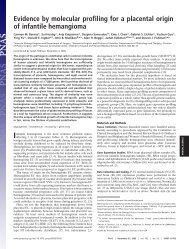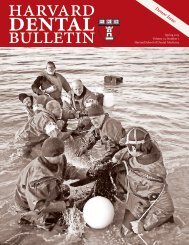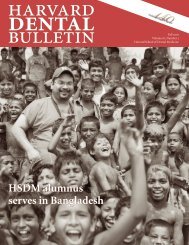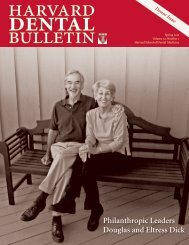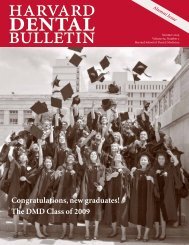Research Issue - Harvard School of Dental Medicine
Research Issue - Harvard School of Dental Medicine
Research Issue - Harvard School of Dental Medicine
Create successful ePaper yourself
Turn your PDF publications into a flip-book with our unique Google optimized e-Paper software.
alumni fo cusAlumni FocusMortimer Lorber, dmd ’50, md ’52The recipient <strong>of</strong> the 2010 HSDM Distinguished Alumni Award,Lorber has had a distinguished career spanning many decades.The plaque that Mortimer Lorberreceived in May 2010 from the <strong>Harvard</strong><strong>Dental</strong> Alumni Association reads: “Loyalalumnus, noted scientist, scholar, clinician,and mentor: you continue to influencethe health <strong>of</strong> humankind throughmajor preclinical course Introduction toClinical <strong>Medicine</strong>—a series that was presentedfor 25 years and continued evenafter the <strong>School</strong> <strong>of</strong> Dentistry was closedand after Lorber retired, when EdwardMopsik, DMD ’67, took over.your lifelong advocacy for oral healthknowledge in medical education.”Lorber served on the admissions committee<strong>of</strong> the Georgetown <strong>School</strong> <strong>of</strong> DentistryThis is not the first <strong>Harvard</strong> award thatLorber has received. As an HSDM senior,he earned the <strong>Harvard</strong> Medical <strong>School</strong>Undergraduate Assembly <strong>Research</strong> Awardfor “The Histochemistry <strong>of</strong> the <strong>Dental</strong>Cementum and Alveolar Bone.” This workMortimer Lorberfor five years and on its education committeefor 25 years. And every year for 25years, he presented an exhibit on dentalinformation for medical students at theeducational sessions <strong>of</strong> the Association <strong>of</strong>American Medical Colleges. “I have beenwas later published in the Anatomical Record in 1951. Lorberalso received a <strong>Research</strong> Career Development Award from theNational Institute <strong>of</strong> <strong>Dental</strong> <strong>Research</strong> while at the GeorgetownUniversity <strong>School</strong>s <strong>of</strong> <strong>Medicine</strong> and Dentistry, where he taughtfrom 1959 to 1997 and contributed to the Merck Manual.In fact, Lorber distinguished himself for decades as an educatorat Georgetown who was committed to creating bridgesbetween medicine and dentistry. For 38 years, he lectured inthe first-year physiology course for the dental students, eventuallybecoming course director, and organized a student laboratorysession on human salivary secretion. He created, andfor 30 years directed, a course in oral physiology for dentalgraduate students working on MS degrees in oral surgery, periodontics,and prosthodontics. Following the HSDM philosophythat dentistry is a specialty <strong>of</strong> medicine, Lorber workedcontinually to bridge the two disciplines, presenting the samelectures to the dental students that he gave to the medical students,despite Georgetown’s curricula being separate for eachschool. He introduced a required series <strong>of</strong> lectures on clinicaldentistry for second-year medical students as part <strong>of</strong> theirtold that my exhibits inspired the introduction <strong>of</strong> several hours<strong>of</strong> clinical dental information into the curriculum <strong>of</strong> a number<strong>of</strong> medical schools,” he says. Lorber also spread his knowledgeoutside <strong>of</strong> academia, lecturing for 10 years on dentallyrelevant aspects <strong>of</strong> physiology to military dental researchers atthe Walter Reed Army Institute <strong>of</strong> <strong>Research</strong> and the U.S. Naval<strong>Dental</strong> <strong>School</strong>.In addition to pursuing his educational mission, Lorber publishedmany research papers, including one in 1968 in the Journal<strong>of</strong> Investigative Dermatology entitled “Stretching <strong>of</strong> the Skin InVivo: A Method <strong>of</strong> Influencing Cell Division and Migration inthe Rat Epidermis.” This research, notes Lorber, “became thebasic science behind tissue expansion for breast reconstructionand perhaps for bone distraction, which has a dental applicationto elongate the congenitally hypoplastic mandible.”A true academic, Lorber is still active in research and writing.Through his dedication to his field and his pr<strong>of</strong>ession, and hismentoring <strong>of</strong> future leaders in medicine and dentistry, MortimerLorber has indeed proved to be a distinguished alumnus.H5


